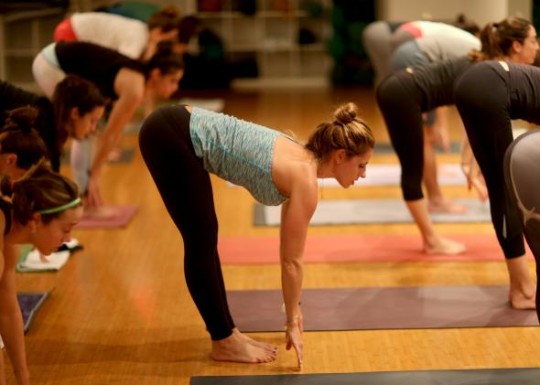Hey guys, I’m out of the office today.
But I wanted to leave you with a tip that you can apply to any script on your hard drive RIGHT NOW.
The tip came about after reading a few amateur scripts this week and noticing a number of bad dialogue scenes where the writers were making the same mistake.
One of the things screenwriting books tell you to do is “have more going on in your scene than just dialogue.” So instead of having two characters sit across from each other and talk at the kitchen table, have them talking to each other while they’re doing the dishes. The idea being that now they’re actually “doing something.”
Or move the scene somewhere else entirely – say, to a yoga class! This change in scenery coupled with a few yoga poses will bring the formally boring-ass dialogue to life.
Unfortunately, this is bad advice. All this does – regardless of the fact that yoga pants are the greatest invention of the 21st century – is make the scene more visually interesting. It doesn’t change that your characters are still just talking to each other.
What you want to do instead is create a reason for why the characters are doing something, and for that reason to have some stakes attached to it. By adding importance to the action, a scene with the exact same dialogue actually does come to life.
For example, let’s go back to that kitchen scene. What if we established that our heroine, JANE, has a nasty husband who goes apeshit if the house isn’t sparkling clean when he gets home from work? And he’s going to be home soon. Now, cleaning those dishes takes on a whole new meaning, right? If they’re not clean by the time Psycho Hubby gets back, there will be hell to pay. There are actual stakes attached to getting those dishes done.
Or let’s put Jane back in that yoga class with her friend, KERRY. This time, instead of using yoga as a location to spout off some boring dialogue you’re trying to get in, make it so Jane likes one of the guys in class. And Jane and Kerry map out a plan ahead of time to get his attention. These newfound stakes (trying to get this guy’s attention) give a formally directionless scene purpose.
The cool thing about this device is it improves the dialogue without you even having to change it. Let’s say that kitchen dialogue scene had Jane and Kerry discussing the difficulties of motherhood. Without Pyscho Hubby coming home, the conversation is just that, a conversation. With Psycho Hubby, the same conversation feels like it’s being used to fill in the silence and help alleviate the anxiety both women feel from that looming arrival.
The lesson here is to never have your characters performing random actions or going to random locations in the hopes that that will improve the scene. Create a purpose to the scene that includes stakes so that what the characters do actually matters. Only then will the dialogue come to life.


